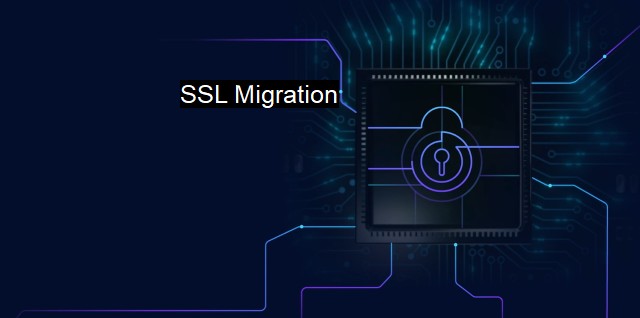What is SSL Migration?
SSL Migration: Enhancing Web Security and Protecting User Data through SSL/TLS Encryption
SSL Migration is a cybersecurity process that refers to the movement from one SSL (Secure Sockets Layer) protocol version to another to maintain continuous and strong security over internet connections. SSL, which transforms into Transport Layer Security (TLS) with more advanced features, is a technology that creates secured and encrypted links between web servers and a user's browser. This serves to ensure that all data passed between the two remains private and integral. SSL Migration is particularly crucial since each technology involved in secure internet connections, such as SSL and TLS, undergoes continual updates and enhancements to counter ever-evolving cyber threats and vulnerabilities.SSL was initially developed as an integrity assurance tool between personal computers and servers over the internet. Over time, cybersecurity professionals identified several vulnerabilities intrinsic to SSL that are susceptible to compromise. This led to subsequent iterations of the protocol, eventually called TLS. Each version incorporates enhanced cryptographic techniques, improving secure communication over internet connections above an array of devices, including mobile and handheld ones.
SSL's primary function is to safeguard sensitive data, such as banking and credit card information, passwords, personally identifiable information and other important interactions transmitted over the internet from being intercepted by malicious third parties. Originally, most websites did not bother to use SSL until they had to manage transactions or personal data - pages displaying information only would commonly use HTTP. due to recent cybersecurity threats like phishing, MITM (Man-In-The-Middle) attacks, SSL/TLS is nowadays recommended for all sorts of websites and applications.
Therefore, SSL Migration process aims to upgrade from outdated SSL protocols to newer TLS protocols. This migration is prompted by inherent weaknesses in older SSL versions (like SSL 2.0 and SSL 3.0) exposed by cyber attacks resulting in the theft of sensitive data. issues regarding compatibility with legacy systems, pressured timelines, resource constraints often challenge organizations undertaking SSL Migration.
Migration safeguards web communications by eliminating weak ciphers and enforcing robust encryption methods. When organizations neglect to carry out SSL Migration, they expose themselves and their users to unnecessary cybersecurity risks. At the same time, the consequence of not taking action is becoming increasingly severe, with regulations and compliance requirements that impose strong penalties for not appropriately safeguarding sensitive information.
During SSL Migration, enterprises often rely on cybersecurity software and antivirus solutions to facilitate a smooth transition and mitigate potential data breaches. These solutions offer crucial protection against breaking the encrypted secure communication. they help organizations identify and patch vulnerabilities that could be misused by hackers during the SSL Migration process.
A part of the migration process is end-point security, which works to neutralize possible vulnerabilities. A vital element of end-point security is antivirus software. Potential security breaches such as trojans or viruses might exploit the periods of transition. Antivirus software counters this by identifying potential threats within devices and networks and subsequently quarantining or eliminating them.
SSL Migration is a critical process in today's digital age. It elucidates all the measures required to upgrade from the SSL to TLS protocol for continuous encryption and protection of internet data transactions. The entire process, meticulously monitoring the transition, should be aligned with robust cybersecurity management and antivirus implementations to ensure integrity, confidentiality, and availability of data and systems across all platforms.

SSL Migration FAQs
What is SSL migration and why is it important in cybersecurity?
SSL migration refers to the process of switching from older SSL/TLS protocols to newer, more secure versions. It is important in cybersecurity because SSL/TLS is the foundation of secure communication on the internet and outdated versions can leave systems vulnerable to attacks.How do I know if my website needs an SSL migration?
If your website is still using SSL/TLS protocols that are outdated or vulnerable to attacks, it is likely in need of an SSL migration. You can use online tools or consult with a cybersecurity professional to assess your website's security and determine whether an SSL migration is necessary.What are the benefits of SSL migration?
The benefits of SSL migration include improved security for your website, protection against cyber attacks, and compliance with industry standards and regulations. It can also enhance user trust and credibility, as SSL/TLS encryption helps to safeguard sensitive information and create a secure environment for online transactions.How can I ensure a successful SSL migration?
To ensure a successful SSL migration, it is important to work with experienced cybersecurity professionals who understand the complexities of the process. They can help identify potential issues and ensure that the migration is executed properly. Additionally, it is important to communicate with your website users or customers about the migration and its benefits, so that they understand the importance of the security measures being taken.| | A | | | B | | | C | | | D | | | E | | | F | | | G | | | H | | | I | | | J | | | K | | | L | | | M | |
| | N | | | O | | | P | | | Q | | | R | | | S | | | T | | | U | | | V | | | W | | | X | | | Y | | | Z | |
| | 1 | | | 2 | | | 3 | | | 4 | | | 7 | | | 8 | | |||||||